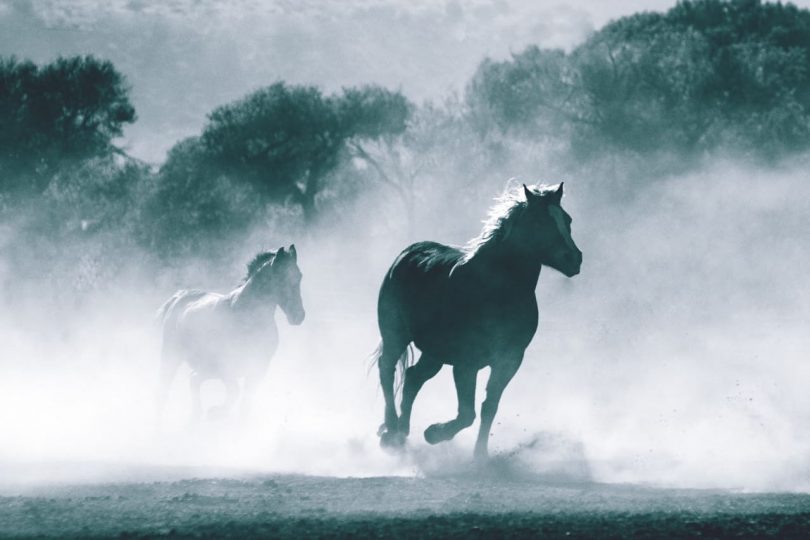“Non-attachment” sounds a bit intimidating, doesn’t it?
Unfortunately, most people tend to associate this spiritual phrase with being emotionally cold and unfeeling. But true non-attachment is quite the opposite: it allows us to live in this world fully, without being attached to people, things or thoughts that create suffering.
As the Dalai Lama was once quoted to have said:

Spiritual Wanderer Course:
⭐️⭐️⭐️⭐️⭐ "I started the Spiritual Wanderers Course a short while ago and for the first time in twelve years I have started to experience love, acceptance and compassion for myself and within myself. Thank you so much." – Vivienne S.
Attachment is the origin, the root of suffering; hence it is the cause of suffering.
But we don’t have to sell everything we own and become monks or nuns to practice non-attachment; we simply need to understand the vital importance of letting go.
Non-attachment or release from desire has been spoken about in many religions such as Taoism, Hinduism, Jainism, and the Bahá’í Faith, but this concept is most commonly linked to Buddhism.
Here are a few perspectives from major spiritual traditions on non-attachment:
The root of suffering is attachment
– The Buddha (Buddhism)
When we come to non-attachment, then we can understand the marvelous mystery of the universe: how it is intense activity and at the same time intense peace, how it is work every moment and rest every moment.
– Swami Vivekananda (Hindu Tradition)
Consider the trees which allow the birds to perch and fly away without either inviting them to stay or desiring them never to depart. If your heart can be like this, you will be near to the Way.
– Zen saying
Act without expectation
– Lao Tzu (Taoism)
He who is attached to things will suffer much.
– Tao Te Ching
Aparigraha (or Non-attachment)
(One of the three pillars of Jainism)
Attach not thyself to anything unless in it thou seest the reality of God.
– Abdu’l-Baha (Bahá’í Faith)
Detachment is not that you should own nothing, but that nothing should own you.
– Ali Ibn Abi Talib (Islam)
There are simply too many quotes out there on non-attachment to include here, but I hope these perspectives give you an idea of how important non-attachment is not only religiously/spiritually, but on a global level.
Table of contents
What is Non-Attachment?

Non-attachment is not about being a cold or emotionally dead brick wall, instead, it’s about learning how to let go of the thoughts and emotions that create suffering. Once we can stop being so attached to our thoughts, we experience tremendous relief, inner peace, and a pervading sense of joyful well-being.
So how do we let go of our thoughts and emotions? We must learn to observe and disentangle ourselves from our thoughts through practices such as mindful awareness, meditation, and self-inquiry.
When we can simply allow life to unfold naturally without being attached to outcomes, beliefs, feelings or opinions, then we experience true non-attachment. Picture this process of detachment like being an ice cube that slowly melts down into a puddle of flowing water. Water, like the practice of non-attachment, flows with life effortlessly and peacefully, whereas ice cubes do not. The goal of non-attachment, therefore, is to become like water.
Essentially, non-attachment is about letting go of everything, both physical and non-physical – or what spiritual teachers such as Eckhart Tolle refer to as “dying before you die.” At first, this sounds scary, but dying before you die really only means letting go of everything that is preventing you from finding what is true, eternal, unchanging, and forever present.

Shadow & Light Membership:
⭐️⭐️⭐️⭐️⭐ "Receiving these messages is a beacon of light and hope for me in currently very challenging times. The words of wisdom speak right to my soul, guiding and encouraging me further on my path. I highly recommend Shadow & Light to everyone who seeks to develop and cultivate a relationship with the Inner Self." – Karin
In the words of Tolle,
Death is a stripping away of all that is not you. The secret of life is to die before you die – and find that there is no death.”
So non-attachment, at the deepest level, is about returning back to your True Nature or Higher Self by loosening the grip of the mind on internal and external things.
14 Benefits of Non-Attachment

When we stop clinging to internal and external phenomena, our whole relationship with life is transformed. Here is what may (or may not) happen when you learn how to practice acceptance and surrender:
- You will stop being controlled by your emotions, instead, you’ll become interested in them
- You won’t be attached to the outcome, meaning that you’ll be free from the dread, anxiety, and inner tension that comes with clinging to expectations
- You’ll be more curious, open, and spontaneous because you have no predetermined desire or craving
- You’ll be more peaceful and less neurotic, meaning that your relationships and friendships will drastically improve
- You’ll feel consistently relaxed and serene because you’re not identifying with your thoughts and feelings (and instead you’re witnessing them as a “passive observer”)
- You’ll be more resilient in the face of loss and death because you’re not attached to people and realize that all things are ephemeral
- You’ll feel a sense of expansive freedom because you’re no longer a slave to the mind
- You’ll feel a sense of wholeness because you don’t need or want anything in particular, you’re happy just as you are in the present moment
- You’ll feel more love for yourself and others because you’re not attaching to beliefs and expectations about who you/others “should” be or what “shouldn’t” happen – you’ll give yourself and other people freedom to be themselves without judgment
- You’ll experience more synchronicity as life unfolds effortlessly and naturally
- You’ll no longer be addicted to “getting” things or filling an empty hole in yourself because you’re content and don’t attach to the belief that someone or something will “complete” you
- You’ll feel more grounded and connected to life because you’re not lost in thought-based attachments – you’ll actually participate in life more fully
- Your mind will become clear and you’ll be able to perceive the truth more easily
- You’ll feel gratitude, love, compassion, and happiness permeate your life as you have let go of the need to chase happiness (which creates unhappiness)
Put non-resistance and non-judgment together with non-attachment, and you have a recipe for complete inner peace. Why? When we stop resisting life and judging things to be “good” or “bad,” we naturally let go of a lot of anger, hatred, fear, and sadness.
The Mistake of Attaching to Non-Attachment

After hearing about non-attachment the tendency of the mind is to instantly fire up and start masterminding ways of “achieving” non-attachment. But be careful! Even the desire to want no desire is still a desire!
The whole point of non-attachment is to begin paying attention to your thoughts. What occupies your mind all day? What drives you? In what ways are you seeking happiness from the external world rather than the internal world?
Non-attachment is a concept that helps us to explore what is happening within us … but at the same time, it can easily become yet another attachment. So pay attention. Be wary of allowing non-attachment to become yet another “Trophy” you’re trying to add to your spiritual cabinet because it doesn’t work that way. It is impossible to practice true non-attachment when we’re attached to the desire to be non-attached.
How do we prevent this (largely overlooked) attachment from happening? We’ll explore that soon. But first, let’s examine the:
3 Kinds of Attachment

In order for us to transform and evolve, it’s essential to discover what our strongest attachments are in this world. In my own journey so far, I’ve discovered three main types of attachment. Which can you relate to the most?
1. Material Attachment
It’s no wonder that many of the sages and spiritual masters of the world were sojourners for most of their lives, having little food or money, and certainly no land or property to claim as their own. Their behavior points to a higher truth: that material possessions are meaningless and transient. The more you have physically, the more you have to lose, and thus, the more worried you become about losing it all.
Would you like to save this?
Your information will never be shared.
When our happiness and security lies in the external world of objects and things, we are in constant peril. At any moment our houses could burn down, our treasures could be stolen, our bank accounts could be hacked, our businesses could go bust. Attachment to the material world is like building a fortress on shifting sands: your house is bound to crumble and fall one time or another.
If you struggle with material attachment you:
- Love the prestige of having a stylish house, designer car, fancy clothing, and other items that indicate how wealthy and successful you are.
- Gain your self-esteem and happiness from material possession, e.g., you love having the latest iPhone and without it, you’d feel outdated (and like a bit of a loser)
- Dream about living in a better house, having a better kitchen, a more expensive surround sound system, a larger pool, renovating the garden, and so forth – you gain a lot of pleasure from these daydreams
- Shopping sprees make you excited; you love bringing back bags of clothing, accessories, shoes, and other household items
- Can’t stand the thought of losing all of your possessions in a natural disaster
- Feel as though you couldn’t do without certain items or luxuries
- Feel as though insuring your possessions is essential for your well-being – you want some kind of monetary reimbursement if you lose something (… to buy it all back again)
- Love surrounding yourself with beautiful furniture, linen, paintings, etc. They’re all absolutely necessary to enhance the quality of life and your well-being
- You’re extremely upset or annoyed when something you want discontinues or sells out
2. Personal Attachment
Unlike personal attachment, being non-attached to a person/people means being able to coexist with them without using them as a means towards an end. In other words, personal non-attachment is not needing anyone for acceptance or validation.
Unfortunately, many of us unwittingly fall into the trap of using other people to create our happiness. This is also known as conditional love, as a person loses their value to us once they cease to be a source of comfort in our lives.
The person who has developed non-attachment, on the other hand, gains their love, acceptance, and validation from themselves, rather than from others, this is why there are different styles of attachment. Thus, they are able to love unconditionally regardless of what role the person plays in their lives.
If you struggle with personal attachment you:
- Emotionally distance or completely cut off someone from your life once they become problematic or cease to be a source of personal validation for you
- Feel lost and alone without the unceasing support of a loved one
- Feel agonized for years after a person stops loving you
- Hold grudges and find it hard to forgive people who have hurt you
- Are needy and clingy – you struggle to provide your loved ones with the freedom they need to thrive (and you need their constant attention to be mentally sound)
- Are manipulative; you can be deliberately or unconsciously self-destructive in order to gain attention, love, and affection
3. Thought Attachment
Perhaps the most insidious of all, thought attachment can destroy physical, emotional, psychological, and interpersonal well-being in the blink of an eye.
When we attach ourselves to a belief, expectation, preconceived notion, or idea – especially if these are negative or harmful – we in a sense walk around with a loaded gun. Eventually, we end up shooting ourselves, and others, with our thought attachments: it’s practically inevitable.
When we attach ourselves to a thought, we do so because they bring us either comfort, ego justification, or a sense of order and security. For instance, many of us possess thought attachments like: “I’m always like this. I can never change”, “Those people are all a bunch of idiots/thugs/thief’s/liars, etc.,” “I have found the truth! I’m right and they’re all wrong,” “My life should be like this _________,” “It will always be this way. It will never change.”
Those who are strongly attached to their thoughts tend to use extremist language, canceling out all other perspectives or possibilities and creating psychological and emotional tension, harm, and limited perception. The vocabulary usually includes words and phrases like “should,” “right/wrong,” “good/evil,” “always,” “never,” “forever,” “they are all,” “you are all,” “I am always,” “they are always,” “you are never,” “they are never,” and so forth.
Thought non-attachment, on the other hand, observes a thought, but does not identify with it, and therefore does not attach to the thought. This experience is usually developed by quieting the mind, such as in the practice of meditation, where one learns the true nature of thought: that all thought arises spontaneously and we do not control our thoughts. Because we do not control our thoughts, we are not our thoughts, we are the space behind them (also known as Consciousness). Therefore, why should we take them so seriously?
Thought non-attachment allows us to be liberated from the narrow cycles of the mind that we become trapped in, to a more expansive and open-minded perception of the world.
If you struggle with thought attachment you:
- Tend to try and “figure everything out” all the time
- Believe certain cultures or groups of people are all alike
- Are quite hard and judgmental towards yourself, and thus are hard and judgmental towards others
- Stereotype people easily
- Believe people and situations are either entirely good, entirely bad, entirely right, or entirely wrong
- Tend to see the world in black and white, e.g., something or someone is always like this, or never does that
- Often get lost in your head: your thoughts seem to possess you
- Feel controlled by your thoughts: they can easily make you extremely sad, bitter, angry, jealous, etc.
Don’t feel dismayed if you can relate to one (or all) forms of attachment. We are all imperfect, we are all human, and that’s perfectly okay. Simply being aware of these forms of attachment, however, will help give us that extra centimeter of space between our True Nature and our false attachments.
How to Stop Being Attached to Thoughts, Feelings, People, and Circumstances

Non-attachment is usually the byproduct of spiritual practices such as self-discovery, self-acceptance, and self-love. Here are some useful ways to begin letting go of habits, desires, and thought-patterns that no longer serve you:
For over a decade, we've strived to make this website a haven of free, valuable information. Imagine a world where this knowledge wasn't readily available. If this post sparked a meaningful insight or helped you in any way, please consider a donation as a heartfelt "thank you" for keeping this resource free. Every contribution, big or small, allows us to keep giving back.
1. Stop looking for happiness in external things
When we chase happiness by believing that someone or something outside of ourselves can make us happy, we suffer. In fact, the pursuit of happiness is the greatest form of attachment there is in society. Instead, try to direct your attention inwards. At first, seeking happiness from within (involution) can be extremely difficult as we’ve been conditioned to find “happiness” in material things, accomplishments, titles, and people. But with practice, you will start to find the peaceful center within you known as your soul. Regularly setting aside time to be quiet and still with yourself can help you tune into this inner space.
2. Let go of the “shoulds” and “musts”
How do you approach life? Are the words “should” and “must” a big part of your vocabulary? Expectations (which are mental attachments) are always prefaced with one of these two words, for example, “He should be nicer,” “I must achieve this or I will be a failure,” “They should stop doing that immediately.” Pay attention to the use of these two words and how they reflect in your behavior. Are you believing that something “should” happen or someone “must” be a certain way? Let it go. You cannot change people. Allow life to flow without imposing useless expectations onto it.
3. Practice allowing
Allowing is about permitting life to be just as it is. Allow your thoughts. Allow your emotions. Allow things to not go the way you expected. In the words of Abraham Hicks, “The Art of Allowing is the art of finding my alignment, and therefore, living in joy no matter what’s happening around me.” By allowing life to happen, you stop resisting and suffering ceases.
4. Make friends with uncertainty
We control, obsessively plan, and try to predict things out of pure fear. But the problem is that the more we resist uncertainty, the more paranoid, anxious, and tense we become. When we learn to embrace uncertainty and to allow life to unfold as it wants, we don’t experience fear anymore – instead, we feel calm, curious, and open to all possibilities. This openness allows us to adopt a playful attitude towards life because we’re no longer limited by fearing the unknown. Sometimes a simple shift in mindset can help you befriend uncertainty instead of loathing it. For example, instead of dreading “what will come around the corner” start perceiving the unknown as a big surprise waiting to happen.
5. Learn to observe your thoughts and feelings
The easiest way to observe your thoughts and feelings is through a regular daily meditation practice. I recommend trying Vipassana meditation as it helps you to stay grounded while discovering with first-hand experience that you are not your thoughts: your thoughts are simply fluctuations of energy that rise and fall like waves in the ocean. The more you incorporate thought-awareness into your life, the more readily you’ll see how irrelevant many thoughts are: they only mean something when you assign them meaning. When you don’t give thoughts importance, they cease to cause you pain.
6. See how transient all things are
Look around you and try to find something that will last forever. Who or what will last eternally? The reality is that all things will sooner or later die. By reminding yourself of this fact, you will start living life as fully and completely as possible. Seeing the transience of life is deeply saddening but also gives us the opportunity to experience true joy. If everything lasted forever, what a boring thing life would be! Death helps us to appreciate life. So appreciate it while you have it. Furthermore, use this recognition to fuel your pursuit to find that which doesn’t change, or that which is eternal. Start looking within and you will be surprised … or more than surprised, ecstatic!
***
Non-attachment and letting go, go hand in hand. If you want more guidance on how to let go, I recommend checking out our article 42 Powerful Ways of Letting Go of Anger and Heartbreak. This article is packed to the brim full of helpful tips and advice.
When all has been said and done, non-attachment is one of the keys to experiencing an enlightened form of living which is grounded in the here and now, and is wildly and utterly alive. Non-attachment isn’t about becoming some dull “emptied” husk-of-a-person – it is about living with the aliveness, rawness, and simplicity of a true Master.
So now I’ll turn it over to you: what are your thoughts on non-attachment? Do you have any useful tips to share with this community?
Whenever you feel the call, there are 2 ways I can help you:
1. The Soul Work Compass Course: Ready for deep transformation without the fluff? The Soul Work Compass provides a step-by-step path to finding your inner truth and life direction. Heal core wounds, clarify your values, and walk away with a concrete guide for living. Get started now!
2. The Inner Work Journal Bundle: Stop surface-level healing. Dive into the depths with 150+ journaling prompts designed to help you face your demons, heal childhood wounds, and embrace your shadow. Three sacred journals, lifetime access, print as many times as you need. Real transformation starts here.



 $3
$3



Letting go or being non-attached seems inconsistent with the Law Of Attraction. But then I have figured out everything in the wonderful world of spirituality is an enigma. Is there any point in being without a goal? The sounds like chaos which accomplishes nothing. I guess at this point all one can do is search for something like enlightenment knowing you won’t be able to recognize or appreciate it yet when you do find it. But at least it gives you something to look foward to.
Important topic. I like to practice what I learned as “loving-detachment.” In this awareness, I am not careless or carefree. I can step back from anyone or thing with love. It’s a way of seeing the big picture. Looking at life from the eagle’s perspective. I experience being in it but not of it. I like loving-detachment because I don’t remove myself with a sense of distinction. I step back andobservewith love in my heart.
Thank you for sharing your experiments with this John, I like how you’ve described the ‘loving-detachment’ awareness technique. For me, meditation has helped a lot maintain this level of ‘inclusion without involvement’ with the unfolding of moments. :)
Interesting read, Sol.
A lot of “You’ll” in there, however, that in and of itself is loading people what they will and should expect; that in and of itself is a part of attachment, at its very core. Not everyone will experience these things, nor in the way you believe it should.
Some of us, have never felt what people call, “happiness”, we have to mimic it, so that we don’t appear to extremely abnormal to the masses. I don’t feel any different from the time I was ” attached” to the time after, as in non-attachment. Now, my perception of how things work, that’s different, that’s what did change, emotions did not.
Thank you for your thoughts Lex :).
There is quite a bit expectations created through the language, I agree. When it comes to non-attachment, anything from the non-duality philosophy, language really falls short to communicate it, much less so through writing, perhaps this is why the philosophy is primarily past on verbally.
The example of ‘happiness’ is a great one. The greater our non-attachment, the more of a centerless sense of self we find; and the less affected we are by emotions like happiness or unhappiness. But when explaining something to beginners, to express the ‘rewards’ for practicing non-attachment as a ‘centerless self’ or ‘tranquility’ falls short and doesn’t sound very motivating to pursue at all.
We only really fully understand it when we experience the ‘perception shift’ you mention. Hence the dilemma of talking about these topics at all, and yet we must start somewhere.
I read this article just as the time I mostly need these words. Thank you so much.
For so long, I thought i was in this state of non- attachment until i was brought to face a situation where i found out that I am still totally attached to everything i thought i wasn’t attached anymore. And so I thought, I still don’t know anything at all. Reading this article reminded me to go back to my Inner world. Thank you so much.
I’m grateful this article has provoked the desire to trace your steps and reexamine things Menchie :)
Thank you so much for your work! I have just found you but will be a loyal follower for sure because the awakening process is working in me enough to be able to differentiate valuable spiritual messages from the non-transformative ones. And yours I feel to be true while at the same time it is entirely practical which is of great help in this transformation phase where I am. Thank you for your work, keep your fire up high to shine to many! Btw I found you on Insta, you were in the top 3 results when searching for #enlightenment or #awakening or stg like this.
Namaste
Thank you Emese, I’m happy to hear you resonate with our work so well. Let me be the first to welcome you to our pack. :)
It is good you have brought this topic into our consciousness and understanding, than you. Jesus of Nazareth spoke of non-attachment in the context of leaving family and following him and where a person’s treasure is, that is where their heart is. The summary of this is everything, including us in bodily form, is transient and freedom from attachment is liberating. As I often say : every-thing is no-thing unless, or until, we give it meaning and attachment.
Just one small point to gently push back : there is nothing wrong with acquiring material belongings because they are beautiful or useful providing we are aware, conscious, that they are temporal. As William Morris said (paraphrasing here) “have nothing in your house which is neither useful or beautiful”. All things come from God/Spirit/ The Universe – the mindful approach is to be aware that nothing lasts for ever and to be aware the desire for material belongings is a bad master. Take money : the desire for money” is the root of all evil” and money then becomes the master. Having money with non-attachment, makes it the servant. After all, money is only a means of exchange and fundamentally is energy; it only becomes something when we give it meaning and attachment !
Enough from me……..I always enjoy your weekly blogs.
Namaste and blessings…..
Thank you Rob for sharing your insights. I couldn’t agree more, there’s nothing wrong with material belongings (Tantrikas are really insightful in this perspective). Ultimately what matters is our relationship to the world and its content, and not so much this or that.
This is where so many religions have gone amiss, trying to capture an internal experience as is mora ‘right action’ (using Buddhism terminology) and turn it into dogmatic rules to follow. We cannot easily transmit and pass on the understanding of ‘how to relate to the world through changing our perception’ so we opt for the next best thing which is more easily taught and that is written commandment/rules to follow in the hopes behaving a certain way will make us feel/experience the truth in it.
I appreciate your thought-provoking comment :).
I first came across this concept from a little book on Buddhism 20 years ago, when I had my first spiritual awakening. I remember realising how profound it seemed at the time, and I realise 20 years later this is likely the most powerful deceptively simple truth us humans will ever come to truly understand. 20 years later your article has made me realise that the trigger of my second and most powerful spiritual awakening this time around was attachment, and to remind me to live in the now and that I have all that I need inside me. But it’s still a struggle. Thought attachment is my dragon to slay. I have realised how incredibly attached I am to the mind and how imbalanced I am from this. The plague of our Western world. The work continues. Meditation, nature, thoughtful reflection help, for a time until old habits persistently set in. But as neuroplasticity suggests, it can take a while to rewire the brain especially with entrenched habits. Good news is we can change but not without practice and dedication, and at times, painful reminders of this truth. My personal goal is to combine empathy and energetic depth of emotion as a sensitive, to deepen my intuitive senses and not cut them off, while maintaining centeredness and groundedness. Quite the task…. Thank you Mateo.
Well said Olivia.
Non attachment is like dissociating. A person cannot simply choose to associate with perceived positive ideas or material. Polarity is balanced such as natural life.
Ideas don’t spontaneously occur when a contious task calls the attention away. Ideas manifest with emotions & sensations to create perspectives, moods, biases & differences. A person’s desires is hardly spontaneous weather subconscious or continuous. A person trains both precocious & subconscious ideation themselves.
Not all spirits manifest into entities either. A mood is a spirit, as influences all areas of mental processes & decision making. It can possess you & transfer to others that are sensitive.
I’m starting to see this sight’s information as immature but with good intentions.
Considering the age of the authorship, it wouldn’t be biologically possible to offer any spiritual advise because of hormones & other impulses.
A psychophysiological response is a idea originating from perception.
I struggle with this concept.
I Agree with and understand the overall principles behind non-attachment and definitely need to work on strengthening this in myself.
Some of my difficulties with this arise from how this may be used as an excuse to turn away from confronting injustice and abuse or as a justification for poor treatment of others.This correlates with a previous post about spiritual narcicissim”. I have experienced this tactic personally and have found it to be most aggravating.(I prefaced my words by stating that I struggle with nonattachment!)
Some of my confusion arises from the fact that this concept is difficult to maintain in the physical world.A world full of injustice and oppression in our personal lives as well as on a societal level?Is it not our responsibility to make an attempt to mitigate these things and to stand up and fight if need be? How does one balance non-attachment in this context?
I believe that there are some things that are inherently wrong and there are things that are inherently right.There are predators out there and they are very real.
If we view the physical world through completely spiritual eyes we risk either allowing abuses to occur to those who cannot defend themselves or we complacently sit back and watch it happen.
Balancing spirituality with the reality of the physical world is difficult to say the least! We can fall into allowing injustice and abuse by dismissing them under the guise of enlightenment and we can justify cowardice under the guise of spirituality. I have been misused and abused and told that I was not advanced enough to understand the motives.I have watched people who claim to be humanitarians and advocates of justice remain silent and close their doors and pretend they don’t see or know that injustice is right in front of their face under the excuse that they are pascifists.
We “should”all try to work on becoming better people spiritually and physically. We cannot separate the two.Only death can do that.
We seem to have a predilection of using one to dismiss the other.I struggle with learning how to balance the two.
Thank you Matthew for your thoughtful comment. Non-attachment is definitely a slippery slope because it can be used to justify all kinds of things, this is why we try to balance the spiritual topics as much as we can with the psychology ‘take responsibility’ approach.
But the thing is, at its very roots spirituality is founded on the premise that there’s no such thing as the “I”, or self. In fact, modern science has shown there to be no ‘free will’. As in, if I ask you to think of a city in any country: which one is it? Now if you carefully observe how that happened, did you go through a list of every city in the world and pick one or did you just let one ‘pop into your head’?
This is where it can become an emotional topic, as we can very well say psychopaths and rapists have little control of their actions at an absolute level, yet subjectively we know they do have control of what they’re doing and thinking.
I believe ultimately the promise of ‘enlightenment’ in spirituality is beyond the ability ‘self’ to achieve (as self cannot will itself out of existence), therefore we must balance that we cultivating a healthy balanced ego and doing work on ourselves even though we know ultimately it’s beyond our free will if we choose to or not.
Thank you Mateo for putting into words what I, at 60, have been discovering lately. You have given me a structure to deepen the journey! I don’t know that I will ever completely be non-attached, but this journey is very freeing and has allowed me to discover love in the tiniest and most mundane situations. One difficulty will be making this journey while surrounded by a culture of attachment. I see that as giving me the opportunity to search deeper. The Zen saying to consider the tree and birds will stay with me now!